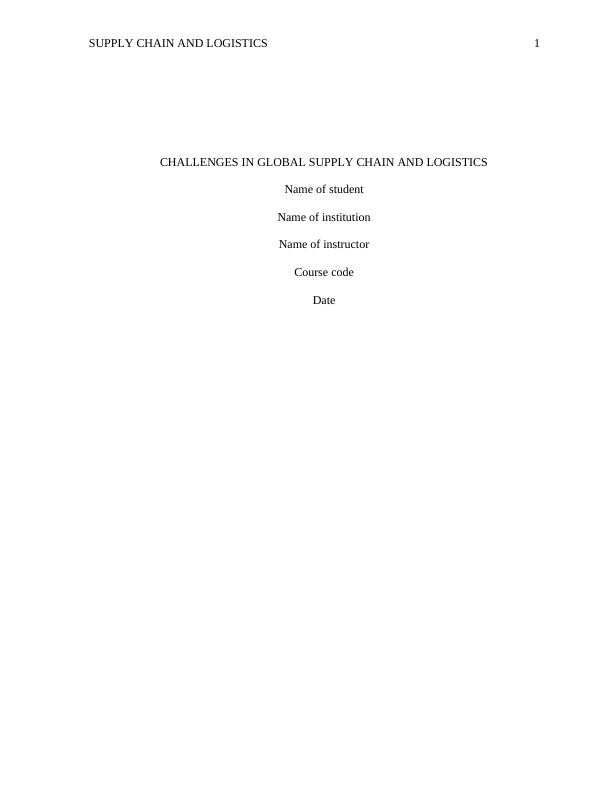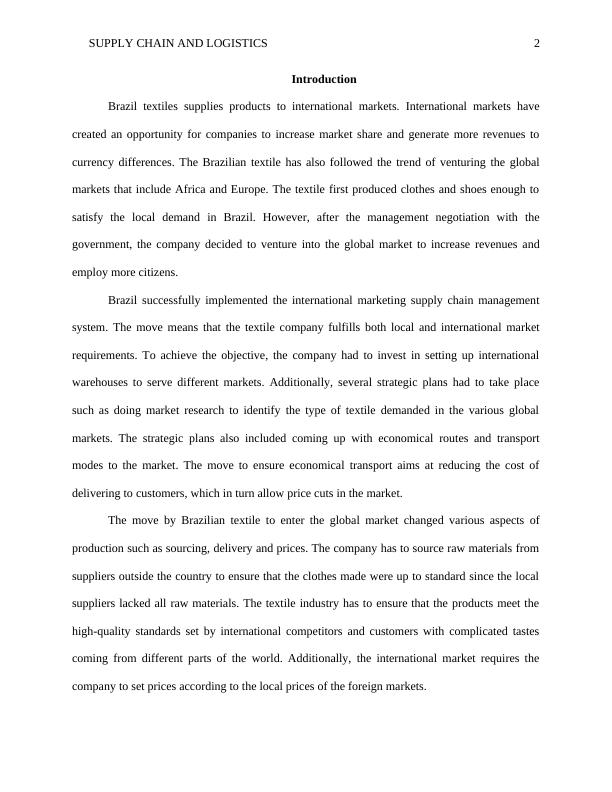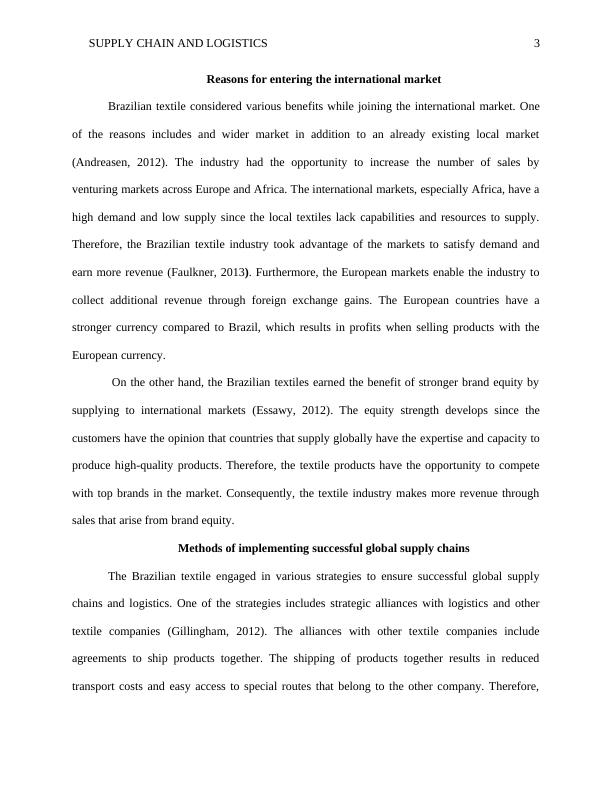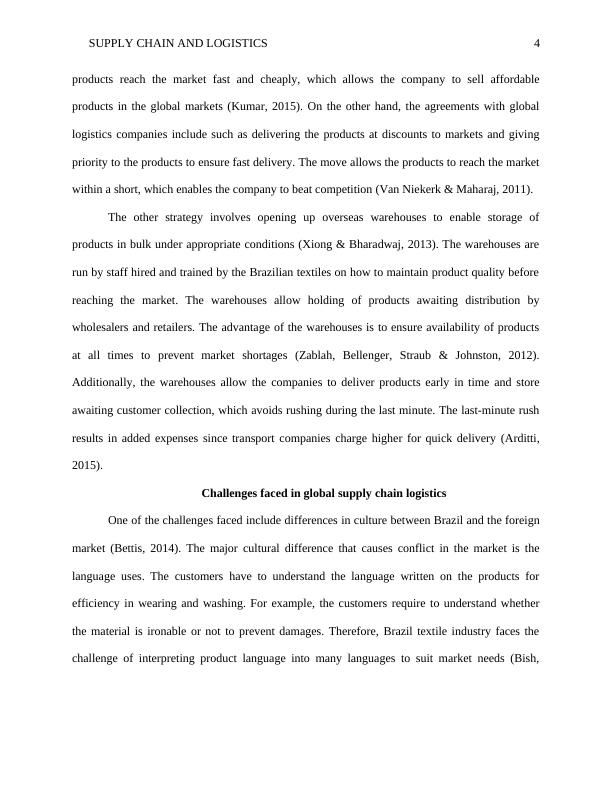Challenges in Global Supply Chain and Logistics
15 Pages4157 Words30 Views
Added on 2023-01-18
About This Document
This study explores the challenges faced in global supply chain and logistics, including economic, distribution, manufacturing, supply, political, and organizational challenges. It also discusses the methods of implementing successful global supply chains and provides valuable insights for supply chain management strategies.
Challenges in Global Supply Chain and Logistics
Added on 2023-01-18
ShareRelated Documents
SUPPLY CHAIN AND LOGISTICS 1
CHALLENGES IN GLOBAL SUPPLY CHAIN AND LOGISTICS
Name of student
Name of institution
Name of instructor
Course code
Date
CHALLENGES IN GLOBAL SUPPLY CHAIN AND LOGISTICS
Name of student
Name of institution
Name of instructor
Course code
Date

SUPPLY CHAIN AND LOGISTICS 2
Introduction
Brazil textiles supplies products to international markets. International markets have
created an opportunity for companies to increase market share and generate more revenues to
currency differences. The Brazilian textile has also followed the trend of venturing the global
markets that include Africa and Europe. The textile first produced clothes and shoes enough to
satisfy the local demand in Brazil. However, after the management negotiation with the
government, the company decided to venture into the global market to increase revenues and
employ more citizens.
Brazil successfully implemented the international marketing supply chain management
system. The move means that the textile company fulfills both local and international market
requirements. To achieve the objective, the company had to invest in setting up international
warehouses to serve different markets. Additionally, several strategic plans had to take place
such as doing market research to identify the type of textile demanded in the various global
markets. The strategic plans also included coming up with economical routes and transport
modes to the market. The move to ensure economical transport aims at reducing the cost of
delivering to customers, which in turn allow price cuts in the market.
The move by Brazilian textile to enter the global market changed various aspects of
production such as sourcing, delivery and prices. The company has to source raw materials from
suppliers outside the country to ensure that the clothes made were up to standard since the local
suppliers lacked all raw materials. The textile industry has to ensure that the products meet the
high-quality standards set by international competitors and customers with complicated tastes
coming from different parts of the world. Additionally, the international market requires the
company to set prices according to the local prices of the foreign markets.
Introduction
Brazil textiles supplies products to international markets. International markets have
created an opportunity for companies to increase market share and generate more revenues to
currency differences. The Brazilian textile has also followed the trend of venturing the global
markets that include Africa and Europe. The textile first produced clothes and shoes enough to
satisfy the local demand in Brazil. However, after the management negotiation with the
government, the company decided to venture into the global market to increase revenues and
employ more citizens.
Brazil successfully implemented the international marketing supply chain management
system. The move means that the textile company fulfills both local and international market
requirements. To achieve the objective, the company had to invest in setting up international
warehouses to serve different markets. Additionally, several strategic plans had to take place
such as doing market research to identify the type of textile demanded in the various global
markets. The strategic plans also included coming up with economical routes and transport
modes to the market. The move to ensure economical transport aims at reducing the cost of
delivering to customers, which in turn allow price cuts in the market.
The move by Brazilian textile to enter the global market changed various aspects of
production such as sourcing, delivery and prices. The company has to source raw materials from
suppliers outside the country to ensure that the clothes made were up to standard since the local
suppliers lacked all raw materials. The textile industry has to ensure that the products meet the
high-quality standards set by international competitors and customers with complicated tastes
coming from different parts of the world. Additionally, the international market requires the
company to set prices according to the local prices of the foreign markets.

SUPPLY CHAIN AND LOGISTICS 3
Reasons for entering the international market
Brazilian textile considered various benefits while joining the international market. One
of the reasons includes and wider market in addition to an already existing local market
(Andreasen, 2012). The industry had the opportunity to increase the number of sales by
venturing markets across Europe and Africa. The international markets, especially Africa, have a
high demand and low supply since the local textiles lack capabilities and resources to supply.
Therefore, the Brazilian textile industry took advantage of the markets to satisfy demand and
earn more revenue (Faulkner, 2013). Furthermore, the European markets enable the industry to
collect additional revenue through foreign exchange gains. The European countries have a
stronger currency compared to Brazil, which results in profits when selling products with the
European currency.
On the other hand, the Brazilian textiles earned the benefit of stronger brand equity by
supplying to international markets (Essawy, 2012). The equity strength develops since the
customers have the opinion that countries that supply globally have the expertise and capacity to
produce high-quality products. Therefore, the textile products have the opportunity to compete
with top brands in the market. Consequently, the textile industry makes more revenue through
sales that arise from brand equity.
Methods of implementing successful global supply chains
The Brazilian textile engaged in various strategies to ensure successful global supply
chains and logistics. One of the strategies includes strategic alliances with logistics and other
textile companies (Gillingham, 2012). The alliances with other textile companies include
agreements to ship products together. The shipping of products together results in reduced
transport costs and easy access to special routes that belong to the other company. Therefore,
Reasons for entering the international market
Brazilian textile considered various benefits while joining the international market. One
of the reasons includes and wider market in addition to an already existing local market
(Andreasen, 2012). The industry had the opportunity to increase the number of sales by
venturing markets across Europe and Africa. The international markets, especially Africa, have a
high demand and low supply since the local textiles lack capabilities and resources to supply.
Therefore, the Brazilian textile industry took advantage of the markets to satisfy demand and
earn more revenue (Faulkner, 2013). Furthermore, the European markets enable the industry to
collect additional revenue through foreign exchange gains. The European countries have a
stronger currency compared to Brazil, which results in profits when selling products with the
European currency.
On the other hand, the Brazilian textiles earned the benefit of stronger brand equity by
supplying to international markets (Essawy, 2012). The equity strength develops since the
customers have the opinion that countries that supply globally have the expertise and capacity to
produce high-quality products. Therefore, the textile products have the opportunity to compete
with top brands in the market. Consequently, the textile industry makes more revenue through
sales that arise from brand equity.
Methods of implementing successful global supply chains
The Brazilian textile engaged in various strategies to ensure successful global supply
chains and logistics. One of the strategies includes strategic alliances with logistics and other
textile companies (Gillingham, 2012). The alliances with other textile companies include
agreements to ship products together. The shipping of products together results in reduced
transport costs and easy access to special routes that belong to the other company. Therefore,

SUPPLY CHAIN AND LOGISTICS 4
products reach the market fast and cheaply, which allows the company to sell affordable
products in the global markets (Kumar, 2015). On the other hand, the agreements with global
logistics companies include such as delivering the products at discounts to markets and giving
priority to the products to ensure fast delivery. The move allows the products to reach the market
within a short, which enables the company to beat competition (Van Niekerk & Maharaj, 2011).
The other strategy involves opening up overseas warehouses to enable storage of
products in bulk under appropriate conditions (Xiong & Bharadwaj, 2013). The warehouses are
run by staff hired and trained by the Brazilian textiles on how to maintain product quality before
reaching the market. The warehouses allow holding of products awaiting distribution by
wholesalers and retailers. The advantage of the warehouses is to ensure availability of products
at all times to prevent market shortages (Zablah, Bellenger, Straub & Johnston, 2012).
Additionally, the warehouses allow the companies to deliver products early in time and store
awaiting customer collection, which avoids rushing during the last minute. The last-minute rush
results in added expenses since transport companies charge higher for quick delivery (Arditti,
2015).
Challenges faced in global supply chain logistics
One of the challenges faced include differences in culture between Brazil and the foreign
market (Bettis, 2014). The major cultural difference that causes conflict in the market is the
language uses. The customers have to understand the language written on the products for
efficiency in wearing and washing. For example, the customers require to understand whether
the material is ironable or not to prevent damages. Therefore, Brazil textile industry faces the
challenge of interpreting product language into many languages to suit market needs (Bish,
products reach the market fast and cheaply, which allows the company to sell affordable
products in the global markets (Kumar, 2015). On the other hand, the agreements with global
logistics companies include such as delivering the products at discounts to markets and giving
priority to the products to ensure fast delivery. The move allows the products to reach the market
within a short, which enables the company to beat competition (Van Niekerk & Maharaj, 2011).
The other strategy involves opening up overseas warehouses to enable storage of
products in bulk under appropriate conditions (Xiong & Bharadwaj, 2013). The warehouses are
run by staff hired and trained by the Brazilian textiles on how to maintain product quality before
reaching the market. The warehouses allow holding of products awaiting distribution by
wholesalers and retailers. The advantage of the warehouses is to ensure availability of products
at all times to prevent market shortages (Zablah, Bellenger, Straub & Johnston, 2012).
Additionally, the warehouses allow the companies to deliver products early in time and store
awaiting customer collection, which avoids rushing during the last minute. The last-minute rush
results in added expenses since transport companies charge higher for quick delivery (Arditti,
2015).
Challenges faced in global supply chain logistics
One of the challenges faced include differences in culture between Brazil and the foreign
market (Bettis, 2014). The major cultural difference that causes conflict in the market is the
language uses. The customers have to understand the language written on the products for
efficiency in wearing and washing. For example, the customers require to understand whether
the material is ironable or not to prevent damages. Therefore, Brazil textile industry faces the
challenge of interpreting product language into many languages to suit market needs (Bish,

End of preview
Want to access all the pages? Upload your documents or become a member.
Related Documents
MKT 5093: Marketing Managementlg...
|6
|1783
|56
International Commercelg...
|9
|1640
|160
Logistics Management and the Impact of Jamaica's Logistic Hublg...
|8
|1721
|462
The Importance of the Chinese Yuan in the Global Economylg...
|3
|735
|404
Assignment On Logistics and Supply Chain Managementlg...
|6
|1037
|77
Supply chain managementlg...
|11
|2923
|50
